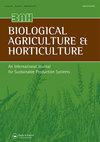有机管理下春大麦基因型的产量稳定性、冠层特性及种传病害
IF 1.6
4区 农林科学
Q3 AGRONOMY
引用次数: 2
摘要
摘要本研究的目的是确定拉脱维亚和爱沙尼亚有机管理农田中生长的稳定高产基因型,并确定其冠层参数和对种子传播疾病的易感性。在三个生长季节的三个地点,使用26个品种和育种系(包括20个有盖和6个无壳基因型)对大麦(Hordeum vulgare L.)进行了田间试验。爱沙尼亚育种系4533.4.3.6的产量显著高于平均水平(3.99 t ha–1;LSD=0.230 t ha–2),并表现出广泛的适应性,如回归系数所示(bi=1.05),回归偏差较小(s2d=0.04),生态价值最低(Wi=1.41%)。根据测得的冠层参数,如生长类型、早期活力、作物地面覆盖和冠层高度,基因型之间存在显著差异。高产大麦基因型的特点是具有更多的亲平面生长习惯和较短的冠层高度,从而在植物生长的早期提供了良好的地面覆盖。Rasa是唯一一个在这两个地方都没有感染松散黑穗病或叶条纹的植物的品种。本文章由计算机程序翻译,如有差异,请以英文原文为准。
Yield stability, canopy characteristics and seed-borne diseases of spring barley genotypes under organic management
ABSTRACT The objectives of this study were to identify stable and high-yielding genotypes grown in organically managed fields in Latvia and Estonia and to determine their canopy parameters and susceptibility to seed-borne diseases. Field trials with barley (Hordeum vulgare L.) were conducted using 26 varieties and breeding lines including 20 covered and six hulless genotypes at three locations over three growing seasons. Estonian breeding line 4533.4.3.6 yielded significantly above the average (3.99 t ha–1; LSD = 0.230 t ha–1) and showed wide adaptability as indicated by the coefficient of regression (bi = 1.05), relatively small deviation from regression (s2d = 0.04) and one of the lowest value of ecovalence (Wi = 1.41%). There were significant differences between genotypes according to the canopy parameters measured, such as growth type, early vigour, crop ground cover and canopy height. High-yielding barley genotypes were characterized by more planophile growth habit and shorter canopy height, thus providing good ground cover in the early stages of plant growth. Rasa was the only variety found to have no plants infected with loose smut or leaf stripe, in either of the locations.
求助全文
通过发布文献求助,成功后即可免费获取论文全文。
去求助
来源期刊
CiteScore
3.30
自引率
6.70%
发文量
18
审稿时长
>36 weeks
期刊介绍:
Biological Agriculture & Horticulture aims to act as the central focus for a wide range of studies into alternative systems of husbandry, and particularly the biological or organic approach to food production. The Journal publishes work of a sound scientific or economic nature related to any aspect of biological husbandry in agriculture, horticulture and forestry in both temperate and tropical conditions, including energy and water utilization, and environmental impact.

 求助内容:
求助内容: 应助结果提醒方式:
应助结果提醒方式:


